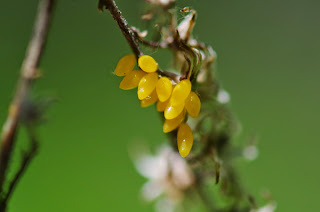I learned something today, though it's a little bit hard to classify what, exactly, I learned. In the concrete sense, I learned what this is:
It is the 'older' larva of a pistol casebearing moth - so called because the case it has made looks like a pistol. So, I was right that it is a caterpillar of some kind. I was apparently calling those kinds of moths by the wrong name - I have been calling them case moths, and according to my book, they are casebearing moths (The book also says the cases are made of bits of food plant and droppings. I do not want to know more about whose droppings they are talking about). The way I found out what this is was a sort of facepalming learning experience: there's a picture of it in one of my bug books. All the web searching I did, trying to figure out the right keywords to search, and I should have just looked in the books - which are more trustworthy anyway. The moral of the story is... probably something about not being lazy. Something to note about this caterpillar: it has been standing on its head like this, not eating, for this whole week. Caterpillars do sometimes take a break from eating when they are getting ready to molt, but this has been a pretty long break, so I would guess it is pupating. Standing on its head.
Backyard Bug of the Day:
I think this is the nymph of a small milkweed bug. I am not 100% sure, because there are several in my book that look like this, but given that it was on a milkweed plant, and we get a lot of small milkweed bugs, I think it's a pretty good guess.
There's this fun thing that happens when you are a bug studier, which is that certain bugs will suddenly appear all over. Today was the first time this year I saw any small milkweed bug nymphs, and I saw several, and in different places in the yard. Today was their day to go public, I guess. Milkweed bugs are Hemipterans, by the way.
Some interesting things:
Last night I read an article about ladybugs, and among the things it talked about was how ladybugs choose where to lay their eggs. It said they choose a place where there are aphids, but not too many aphid (though it wasn't exactly clear on why a lot of aphids would be a bad thing). That leads me to wonder why a ladybug would choose this location to lay her eggs (presuming these are ladybug eggs), given that it is a dead goldenrod plant from last summer and there are no aphids on it. The article also mentioned that new ladybug hatchlings are sometimes cannibalistic, so I fear for the fate of some of these, being hatched in a place where there is no other food for them.
I find discarded exoskeletons of various insects around the yard sometimes, and I think they are fascinating. Such a peculiar way of going about life - grow out of your skin, slip out of it, and leave it there like a ghost of yourself. I am glad to be human (even though I can't fly as a result).
Caterpillars continue to dominate the bug landscape of the backyard:
Casebearing moth caterpillars are especially abundant lately, though not as much as they were last autumn. They are bigger now, though. I wonder if these are the same ones, and they have grown since then (they could have overwintered as caterpillars), or is this a different, larger species? According to my book, there are at least 150 species in North America. It also said that the adults are small and plain - in other words, this weird caterpillar is more interesting than the adult moth. That is often the case - a bright, colorful caterpillar will become a boring, brown moth.
I also find it interesting that the name, casebearing moth, reflects the behavior of the caterpillar, not the moth.
This is probably the largest forest tent caterpillar that I have seen so far.
Extremely close view of the pattern on the caterpillar.
On the same tree, about a foot away. No idea what it is. There are too many green caterpillars for me to even bother looking this up in the hopes of distinguishing it from the others.
I saw another banded hairstreak caterpillar today, but I figured I posted enough pictures of one yesterday.
Random Bugs:
Hoverfly
Sometimes you just can't get a good angle for a shot...
Arachnid Appreciation:
.
.
.
.
.
.
.
.
.
.
.
.
This is the spider that was so bashful last night.























No comments:
Post a Comment